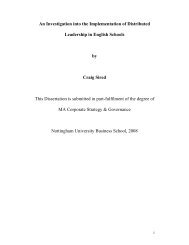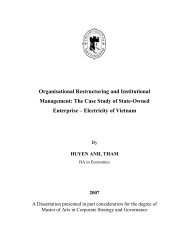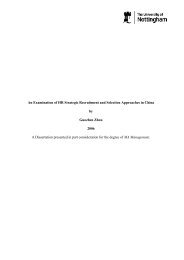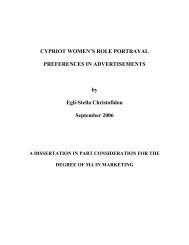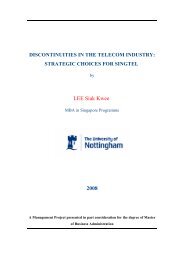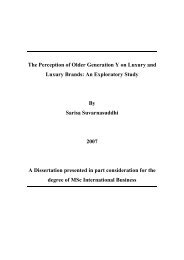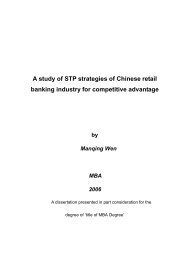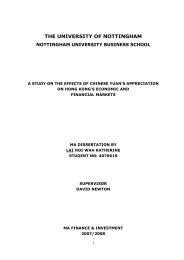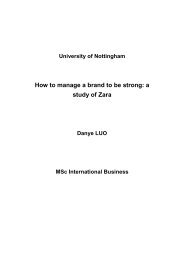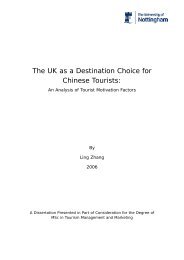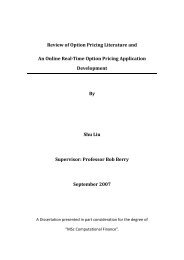application of real options valuation to r&d investments in ...
application of real options valuation to r&d investments in ...
application of real options valuation to r&d investments in ...
You also want an ePaper? Increase the reach of your titles
YUMPU automatically turns print PDFs into web optimized ePapers that Google loves.
Between the end <strong>of</strong> year 7 (the time <strong>to</strong> decide whether <strong>to</strong> launch the compound) andthe end <strong>of</strong> year 17 (the time when the patent <strong>of</strong> Davanrik expires), there areuncerta<strong>in</strong>ties, lead<strong>in</strong>g <strong>to</strong> the existence <strong>of</strong> <strong>real</strong> <strong>options</strong>. Between the end <strong>of</strong> year 0 (thetime <strong>to</strong> decide whether <strong>to</strong> <strong>in</strong>vest on this compound) and the end <strong>of</strong> year 7, there areother <strong>real</strong> <strong>options</strong>, as huge uncerta<strong>in</strong>ty also exist. If the <strong>options</strong> from year 0 and year 7is considered as a s<strong>in</strong>gle option (known as Option A), then it, <strong>to</strong>gether with theabandonment option for the period between year 7 and year 17 (known as Option B)can be seen as a compound option, where Option A must be exercised <strong>in</strong> order <strong>to</strong> keepOption B open. For a compound option, a s<strong>in</strong>gle b<strong>in</strong>omial tree could be used <strong>to</strong> derivethe value. But <strong>in</strong> this case, Option A is a complex compound option as well, and as itis go<strong>in</strong>g <strong>to</strong> illustrate below, it is assumed that option A and option B have differentvolatility and risk-free rate. So here the values derive from B<strong>in</strong>omial Trees (BT) forOption B (the second BT) would be added <strong>to</strong> the last branch <strong>of</strong> the first BT.5.2 Option B (Year 7 <strong>to</strong> year 17)5.2.1 Five variables that determ<strong>in</strong>e the value <strong>of</strong> the <strong>options</strong>Between the end <strong>of</strong> year 7 (the time <strong>to</strong> decide whether <strong>to</strong> launch the compound) andthe end <strong>of</strong> year 17 (the time when the patent <strong>of</strong> Davanrik expires), Merck & Co canchoose <strong>to</strong> abandon the project, at any time before the patent ends (so that there is stillsalvage value), or Merck can expand the scale at a cost or extract with a sav<strong>in</strong>g.However, as discussed <strong>in</strong> Chapter 2, the option <strong>to</strong> expand, extract, or defer may lead<strong>to</strong> other concepts, it is assumed here, Merck & Co only has the option <strong>to</strong> abandon, forthe time between the end <strong>of</strong> year 7 and the end <strong>of</strong> year 17. And s<strong>in</strong>ce this option canbe exercised at any time, it can be seen as an American put option.The value <strong>of</strong> the underly<strong>in</strong>g asset – it should be the ‗present‘ value <strong>of</strong> the net cash<strong>in</strong>flow from the project, but s<strong>in</strong>ce this option beg<strong>in</strong>s <strong>in</strong> year 7, the ‗present‘ value <strong>of</strong>$1200m, $345m, $2250m should be discount ‗forward‘ <strong>to</strong> the end <strong>of</strong> year 7 <strong>to</strong> get thecorrect ‗present‘ value at year 7, by us<strong>in</strong>g the weighted average cost <strong>of</strong> capital <strong>of</strong>Page | 46



